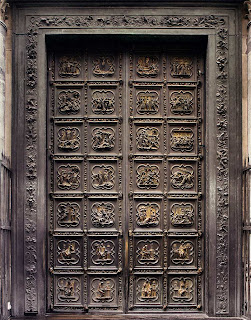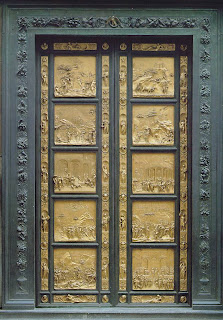Saturday, July 24th, 2010
Ghiberti’s North Doors
Excuse me, Marilyn Stokstad, but I found an error in your art history textbook. Granted, I own a dated version (1999) of Art History (Revised Edition, Volume Two), and I’m hoping that subsequent editions have corrected this error. My copy states the following on p. 647:
“In 1402, a competition was held to determine who would provide bronze relief panels for a new set of doors for the north side of the Florence Baptistery of San Giovanni.” (my emphasis)
This is incorrect. Although the doors resulting from this competition have now ended up on the north side of the baptistery, at the time of the competition these doors were intended for the eastern side of the building.1
The competition to create a set of doors for the baptistery helped revive a project that had been put-aside for several years. When Andrea Pisano had created a set of doors about seventy years before (dated 1330), it was intended at the time that doors would be completed in a similar fashion for the remaining two portals.
Ghiberti won the competition and a set of doors were completed between 1403-1424 (see above left). At the time of completion, Pisano’s doors were moved from their original location on the east side, in order to accommodate Ghiberti’s new doors.2
Although Ghiberti’s doors were installed on the eastern side, later they were moved to their current location: the north side of the building. The same year that Ghiberti completed these now-northern doors, he was given a second commission to complete the last set of doors for the baptistery. This second commission resulted in the famous doors which are known as “The Gates of Paradise” (1425-52, see below right), and are currently located on the east side of the building.3
I feel like there’s a lot of confusion regarding Ghiberti’s doors. So much emphasis is placed on “The Gates of Paradise” (and for good reason), that no doubt many people think that these are the doors which immediately resulted from the competition in 1401-02. If you think about it, though, that assumption doesn’t make a lot of sense. Ghiberti’s submission piece for the competition, The Sacrifice of Isaac (1401) was designed within a quatrefoil shape. Likewise, Brunelleschi (Ghiberti’s rival) completed his submission (also called The Sacrifice of Isaac (1401)) for the competition in a quatrefoil. It’s easy to see Ghiberti and Brunelleschi’s logic for using the quatrefoil; they wanted their doors to match the already-existing door by Pisano. After winning the competition, Ghiberti’s used the quatrefoil shape for all the panels in his now-northern doors. Ghiberti only abandoned the quatrefoil shape when he created the doors for his later commission, “The Gates of Paradise.”
It’s easy to look at the competition submissions and see that the north doors resulted from that historic competition. But you need to be able to see the north doors in order to make that association. Many art history textbooks include images of Ghiberti’s and Brunelleschi’s competition panels (see this example in the most recent version of Gardner’s Art Through the Ages), but then don’t include pictures of the north doors. Instead, “The Gates of Paradise” is shown. It’s too confusing to discuss the 1401 competition and then display doors that weren’t directly associated with the competition! If textbook writers could include just an image of the north doors (even a small one), it could help students keep their facts (and doors!) straight.
*7/25: I made a couple of revisions to this post, having found more information about the original location of Andrea Pisano’s doors and the nature of the 1401-02 competition.
1 See Laurie Schneider Adams, Italian Renaissance Art, (Boulder, Colorado: Westview Press, 2001), 60. In truth, at this time the Florence baptistery needed two portals to be decorated. The aim of the 1401-02 competition was to begin work on this project. For a little bit more information regarding the nature of the competition, see and , “Ghiberti.” In Grove Art Online. Oxford Art Online, http://www.oxfordartonline.com/subscriber/article/grove/art/T031929pg1 (accessed 26 July 2010).
2 Ibid. Today Pisano’s doors are located on the south side of the baptistery. Manfred Wundram and Gustina Scaglia write that Pisano’s doors were originally moved to the west portal, in order to create room for the doors from Ghiberti’s first commission.


Isn't it interesting that major design decisions were and are often made on the basis of a competition? I suppose it was a more democratic process, but even competitions were not as democratic as people believe.
It would be interesting to know who was responsible for making the ultimate decisions for the doors of the Baptistery of San Giovanni in Florence. Was their decision reached fairly? Was the final decision renegotiated under pressure?
Stating Ghiberti won the competition is a bit contentious in some circles M!
In fact, it is mainly Ghiberti who unequivocally stated he won the competition outright. Brunelleschi's biographer Antonio Manetti stated that the Baptistry ideally wanted them to both work on the project, and that this was not viable. This also seems to be the version the director of the Bargello, Beatrice Strozzi, was most pleased with.
Nonetheless, this detail about the Eastern door is an elusive one which you have done extremely well to point out!
To supplement this lovely post, I have also done a quick post featuring an 8 minute clip from the NHK 2004 special on the Bargello – which looks at the 'competition bronzes' in detail.
http://2.ly/cca5
Kind Regards
Hasan Niyazi
threepipeproblem.blogspot.com
Aha! You know, I remember wondering to myself several times in art 101 (I've had to take it like 4 times; 5 if you include the TA position I had as an undergrad) why did Ghiberti change the design of the Gates of Paradise so dramatically from the panel he submitted for the competition? But then I just figured once he had the commission, he decided to do whatever he wanted with it. Haha!
Great post, M. 🙂
Great catch!
Astounding knowledge base! How come you know all this stuff?
greetings from lux1930.blogspot.com
Thanks for your kind remarks, e and LUX Magazine!
I'm glad that both Hels and H Niyazi touched on the point that the competition process probably was not democratic (neither was it fair in outcome, at least from Brunelleschi's perspective). I feel for Brunelleschi. Ghiberti was a thorn in his side, not only because of this competition, but because Brunelleschi was forced to work side-by-side with Ghiberti afterward, when building the dome for the Florence cathedral. Poor Brunelleschi. You can't help but feel for him, especially when one reads Vasari's account of Brunelleschi's work on the dome.
It's also interesting to note that the original contract for the now-northern doors was given to both Ghiberti and his father. (Does this mean that Ghiberti's father also helped to create The Sacrifice of Isaac entry for the competition? Perhaps?) Later, in 1407 the contract was revised to make Ghiberti the main artist.
heidenkind: Ha! I'm glad that someone can attest to the confusion that is created in Art 101 courses. I'm sure that you were not alone. Actually, speaking of Ghiberti's switch from quatrefoil-to-square panel design, I learned something else today: Ghiberti first switched to the square panel format when creating some panels for a bronze font in a Sienese baptistery (San Giovanni, Siena). Ghiberti was invited by the Sienese to work on this baptistery in 1416, when he was already hard-at-work with his first commission for the Florence (now-northern) baptistery doors. These Sienese panels have been marked as Ghiberti's transition to the square panel format (you can see the Baptism of Christ panel (c.1423-1427) from the Siena baptistery here). After this point, Ghiberti continued with the square format for "The Gates of Paradise" in Florence.
I agree with Heidenkind – students need the whole baptistry door story explained very, very clearly. I wrote my notes into a blog post ages ago to set the record straight mainly for their benefit (http://www.arttrav.com/churches/the-baptistry-of-florence/) though of course your post is WAY better! I guess I just assumed that the square panel format was the obvious modern choice since by 1426 the quattrofoil must have been very out of style.
agreed and agreed…how do you catch these thing buddy?
Thanks for including that link, Alexandra! Your post gives a good introduction to the baptistery doors. And I agree with you: the quatrefoil shape would have been outmoded by the time Ghiberti made his second set of doors.
And thanks for commenting, phin! It always makes me happy to know that you read my blog. 🙂
UPDATE: I just received the latest edition of Marilyn Stokstad's "Art History (4th edition, copyright 2011) and this edition does not make the confusion about the north doors. Really, the text eludes defining where each set of doors were placed. It's an improvement from the earlier edition, nonetheless, but I think that more clarification would be helpful.
Such an interesting and informative post. I'm pleased that we were able to include it in this month's edition of the Art History Carnival. Be sure to stop by and see the other articles that were featured in this carnival!